Raymond James Stadium
Raymond James Stadium, also known as "Ray Jay",[5] is a multi-purpose stadium located in Tampa, Florida. It is home to the Tampa Bay Buccaneers of the National Football League (NFL) as well as the NCAA's South Florida Bulls football team and the Tampa Bay Vipers of the XFL. The stadium seats 65,618.[6] With the addition of temporary seating, it can be expanded to 75,000 for special events.
"Ray Jay" | |
Raymond James Stadium, 2007 | |
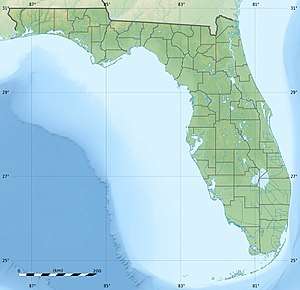 Raymond James Stadium Location in Florida  Raymond James Stadium Location in the United States | |
| Address | 4201 North Dale Mabry Highway |
|---|---|
| Location | Tampa, Florida |
| Coordinates | 27°58′33″N 82°30′12″W |
| Owner | Hillsborough County |
| Operator | Tampa Sports Authority |
| Executive suites | 195 |
| Capacity |
|
| Record attendance |
|
| Surface | Tifway 419 Bermuda |
| Construction | |
| Broke ground | October 15, 1996[1] |
| Opened | September 20, 1998 |
| Construction cost | US$168.5 million ($264 million in 2019 dollars)[2] |
| Architect | Wagner Murray Architects Populous (then HOK Sport) |
| Structural engineer | Walter P Moore Bliss and Nyitray, Inc. |
| Services engineer | FSC-Inc.[3] |
| General contractor | Manhattan Construction, Hunt/Metric Joint Venture[4] |
| Tenants | |
| Tampa Bay Buccaneers (NFL) (1998–present) South Florida Bulls (NCAA) (1998–present) Tampa Bay Mutiny (MLS) (1999–2001) Outback Bowl (NCAA) (1999–present) Gasparilla Bowl (NCAA) (2018–present) Tampa Bay Vipers (XFL) (2020) | |
| Website | |
| raymondjamesstadium | |
Raymond James Stadium hosted Super Bowls XXXV and XLIII, as well as the 2017 College Football Playoff National Championship. It will host Super Bowl LV on February 7, 2021.
History
Raymond James Stadium was built to replace Tampa Stadium at the demand of the new Bucs owner Malcolm Glazer. It is located adjacent to the site of the old stadium on the former location of Al Lopez Field, a minor-league baseball stadium that had been demolished in 1989. Once completed, the final cost of the new stadium was $168.5 million, with the entire cost publicly financed.[7]
It was known as Tampa Community Stadium during construction, but the naming rights were bought for US$32.5 million for a 13–year deal by St. Petersburg-based Raymond James Financial in June 1998.[8] On April 27, 2006, an extension was signed to maintain naming rights through 2015. In May 2016 the Buccaneers announced that the naming rights were extended an additional 12 years ensuring that Raymond James Financial's name will continue to appear through 2028.[9]
The stadium officially opened on September 20, 1998[10], when the Tampa Bay Buccaneers defeated the Chicago Bears, 27–15. The stadium hosted its first soccer game on March 20, 1999, when the Tampa Bay Mutiny lost to D.C. United, 5–2.
The stadium also hosts the annual Outback Bowl college football post-season game on New Year's Day since 1999. The Gasparilla Bowl will be held at the venue starting with the 2018 edition.
The stadium was selected to host the ACC Championship Game in 2008 and 2009.
The stadium is home field for the University of South Florida Bulls of the American Athletic Conference. The team's record crowd at Raymond James Stadium is 69,383, on September 29, 2012, when the Bulls – during their worst season ever – played a non-conference game against the popular Florida State University Seminoles from the powerhouse Atlantic Coast Conference for the first time.
The largest crowd ever recorded in Raymond James Stadium came on January 9, 2017 as the stadium hosted the 2017 College Football Playoff National Championship. 74,512 people were in attendance.
Through to the 2009 season, every Buccaneers game at Raymond James Stadium sold out. In 2010, no home game achieved a ticket sell out, so none could be broadcast on local television. The streak carried over until week four of the 2011 season, when it sold enough tickets for its Monday night game with the Indianapolis Colts on October 3 to avoid a local blackout.
The Monster Jam tour for monster trucks holds an event at the stadium.
Features
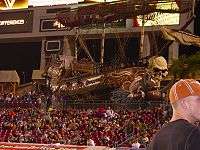
One of the most recognizable features of the stadium is a 103-foot (31 m), 43-ton steel-and-concrete replica pirate ship in the north end zone. Each time the Buccaneers score points, enter the other team's red zone, or win a home game, the replica cannons on the ship are fired off. The cannons fire once for each point scored. In addition, when the Buccaneers enter their opponent's red zone, stadium hosts hoist team flags around the perimeter of the upper deck. During various times throughout the game, the song "Yo Ho (A Pirate's Life for Me)" is played on the stadium public address system (taken from Pirates of the Caribbean), which signals patrons on board the ship to throw beads, t–shirts, and other free prizes to the people below. The segment is also known as a "Mini Gasparilla" to most fans. An animated parrot sits on the stern of the pirate ship. Controlled by radio and remote control, the parrot picks fans out of the crowd and talks to those passing by.[11]
During Super Bowl XXXV on CBS, the pregame, halftime, and post-game desk reporting took place from aboard the pirate ship. NBC's Super Bowl XLIII and ESPN's 2017 College Football Playoff National Championship coverage also emanated from the ship.
The two "Buc Vision" 2,200-square-foot (200 m2) Daktronics video displays were among the largest in the league when they were built. In 2016 they were replaced with 9,600-square-foot (890 m2), HD video boards in both end zones. 'Buccaneer Cove' features a weathered, two–story fishing village facade, housing stadium concessions and restrooms. All areas of the stadium are ADA compliant.
Temporary bleachers were erected in the end zones for Super Bowl XXXV, which set a then-record stadium attendance of 71,921. The stadium attendance record has since been surpassed by the 2017 College Football Playoff National Championship, which also made use of temporary seating.[12]
In 2003, the corner billboards in the stadium were replaced with rotating trilon billboards and these were replaced in 2016 with new high visibility displays.
Raymond James Stadium boasts the second-best turf in the NFL, according to a 2009 biannual players' survey.[13]
In early 2016, the stadium was given an extensive facelift. The most notable improvement was the replacement of the 2,200-square-foot (200 m2) video displays with state of the art, high visibility 9,600-square-foot (890 m2) video displays in both the north and south end zones along with the addition of a new 2,300-square-foot (210 m2) video tower in each corner. All together, the video displays cover more than 28,000-square-foot (2,600 m2), making Raymond James Stadium the third-largest video displays in the NFL. The original sound system and the stadium's luxury boxes were also upgraded.[14] A second round of improvements are planned for after the 2016 season is complete.
Nicknames
The stadium is referred to as "Ray Jay" or "The New Sombrero", a spinoff from "The Big Sombrero", the nickname of Tampa Stadium. Somewhat derisively, it has been occasionally referred to as "the CITS", a name coined by long-time local sportscaster Chris Thomas which stands for "Community Investment Tax Stadium", referring to the fact that the stadium was entirely financed by local taxpayers.[15]
Timeline
- Immediately upon purchasing the Bucs in 1995, new owner Malcolm Glazer declared Tampa Stadium inadequate and began lobbying local government for a replacement.[16] When the community did not move quickly enough to suit the Glazer family, the new owners openly contacted several other cities around the U.S. about possible relocation.[17]
- The city of Tampa and Hillsborough County came up with a plan to fund a new stadium as part of a "Community Investment Tax", which was voted on in a referendum in September 1996. As part of the campaign to pass the referendum, Glazer promised to pay half the cost of the new stadium if fans put down 50,000 deposits on 10–year season ticket commitments. The drive fell 17,000 deposits short, the offer was withdrawn, and the Bucs did not pay any of the stadium's construction cost.[18][19]
- On September 3, 1996, the voters of Hillsborough County approved, by 53% to 47% margin, a 30-year, half–cent sales tax to build new schools, improve public safety and infrastructure, and to build the Buccaneers a $192 million new stadium entirely with public money.[20] The team signed a stadium lease in which the local government must pay for almost all of the stadium expenses while the franchise keeps almost all of the proceeds.[7][21] Former Tampa mayor Bill Poe sued to stop the deal, claiming that giving such a "sweetheart deal" to a private business violated Florida's state constitution.[22] A local court agreed with Poe, but the Bucs and local government appealed. Eventually, the Supreme Court of Florida ruled that the agreement was constitutional, and construction continued as planned.[23]
- On October 31, 1996, the NFL owners met in New Orleans to select the host site for Super Bowl XXXIII and Super Bowl XXXIV. Pro Player Stadium in the Miami area was selected to host Super Bowl XXXIII. Atlanta, Tempe and Tampa were candidates for Super Bowl XXXIV, with Tampa the favorite, following the successful tax referendum. The Georgia Dome in Atlanta, however, was awarded the game. As a compromise, Tampa was awarded Super Bowl XXXV, which the NFL had not originally planned to select that day.
- The last Major League Soccer game played at Raymond James Stadium was on September 9, 2001 when the Mutiny lost to the Columbus Crew, 2–1, in front of 9,932 people. Although the September 11 attacks resulted in the cancellation of the remainder of the 2001 MLS regular season, the Mutiny did not have any more home games scheduled anyway. The Mutiny were subsequently disbanded by the league. National-level soccer matches are still occasionally played at Raymond James, as its wide field makes it ideal for hosting soccer.
- In April 2003, the Tampa Sports Authority proposed passing ownership of the stadium to Hillsborough County to avoid having to pay millions of dollars in property taxes (The Bucs' lease agreement dictated that they not have to pay property taxes). However, Bucs had a right of refusal and refused to sign off on the plan unless the local government paid more of the cost for game–day security and increased the amount of (county-purchased) insurance coverage for the stadium.[24] The dispute continued for months until December 2003, when the county legally declared the stadium a condominium and took ownership. As part of the change, the Bucs were given ownership of portions of the structure. To win the Bucs' approval, the county agreed to refund the team's resultant property tax payments annually.[25][26]
- On May 25, 2005, NFL owners met in Washington, D.C. to select the host site for Super Bowl XLIII. During the balloting, Raymond James Stadium defeated the Georgia Dome (Atlanta), Reliant Stadium (Houston), and Dolphins Stadium (Miami Gardens).
- After a nearly two-year legal battle, the Tampa Sports Authority came to a settlement with popular sports-seating and telescopic platform/bleacher company Hussey Seating of North Berwick, Maine. Following the stadium's opening in 1998, roughly 50,000 Hussey-manufactured seats at Raymond James Stadium began to fade from their original color – a bright, vibrant shade of red – to a shade of washed-out pink. Spotting this obvious defect, the Buccaneers organization pleaded to the TSA to sue the seating manufacturing company for the cost to replace the affected chairs in 2003. Initially, in May 2004, after testing samples of the seats, Hussey Seating did not find any cause for the fading, and thus, found no reason to replace the seats at the company's cost under the current 10–year warranty. After the TSA cited a portion of the warranty which did, in fact, state that Hussey would replace seats if any fading were to occur, Hussey president Tim Hussey admitted an error in the research and eventually would come to a $1.5 million agreement with the TSA to replace the problem seats. Reportedly, the seat-fading occurred due to a manufacturing error by Hussey, as a UV inhibitor – a sunscreen-like component for the plastic – was forgotten in the mixture used to create the seats. All of the problem seats were replaced by new, non–pink seats in the spring of 2006.
- In December 2015, the Buccaneers and the Tampa Sports Authority reached an agreement to complete over $100 million in improvements and renovations to the stadium. The negotiations took months, and were extended by Bucs' lawyers demanding additional concessions after an agreement was near in September 2015.[27] In the end, the upgrades were paid with at least $29 million of public money, with the remainder paid for by the Bucs in exchange for the right to play a home game at another site beginning in the 2018 season and other concessions. Renovations began in January 2016, and the first phase was complete in time for the 2016 football season.[28]
Notable football games
Super Bowl
| Season | Game | Date | Winning team | Score | Losing team | Score | Attendance |
|---|---|---|---|---|---|---|---|
| 2000 | Super Bowl XXXV | January 28, 2001 | Baltimore Ravens | 34 | New York Giants | 7 | 71,921 |
| 2008 | Super Bowl XLIII | February 1, 2009 | Pittsburgh Steelers | 27 | Arizona Cardinals | 23 | 70,774 |
| 2020 | Super Bowl LV | February 7, 2021 | TBD | 0 | TBD | 0 | TBD |
NFL Playoffs
| Season | Game | Date | Visiting team | Score | Home team | Score | Attendance |
|---|---|---|---|---|---|---|---|
| 1999 | NFC Divisional | January 15, 2000 | Washington Redskins | 13 | Tampa Bay Buccaneers | 14 | 65,835 |
| 2002 | NFC Divisional | January 12, 2003 | San Francisco 49ers | 6 | Tampa Bay Buccaneers | 31 | 65,599 |
| 2005 | NFC Wild Card | January 7, 2006 | Washington Redskins | 17 | Tampa Bay Buccaneers | 10 | 65,514 |
| 2007 | NFC Wild Card | January 6, 2008 | New York Giants | 24 | Tampa Bay Buccaneers | 14 | 65,621 |
College Football Games
| Season | Game | Date | Winning team | Score | Losing team | Score | Attendance |
|---|---|---|---|---|---|---|---|
| 2016 | College Football Playoff National Championship | January 9, 2017 | Clemson Tigers | 35 | Alabama Crimson Tide | 31 | 74,512 |
- (14) South Carolina 31, vs. (22) Ohio State 28: January 1, 2002 (2002 Outback Bowl, largest Outback Bowl crowd in stadium history – 66,249)
- (4) Florida State 30, vs. USF 17: September 29, 2012 (largest USF Bulls home game crowd in stadium history – 69,383)
- (2) Clemson 35, vs. (1) Alabama 31: January 9, 2017 (2017 College Football Playoff National Championship, largest crowd in stadium history – 74,512)
Soccer
The stadium was also home to the former Tampa Bay Mutiny of Major League Soccer and continues to periodically host other soccer matches due to its accommodating field dimensions. For example, on June 8, 2012, it hosted the United States men's national soccer team's opening qualifying match against Antigua and Barbuda for the 2014 FIFA World Cup, which the United States won 3-1.[29]
On October 11, 2018, the Colombia men's national soccer team played against the United States men's national soccer team and won 4-2 to set the current attendance record of 38,361 for a soccer match at this stadium.[30]
International Soccer Matches
| Date | Winning Team | Result | Losing Team | Tournament | Spectators |
|---|---|---|---|---|---|
| June 8, 2012 | 3–1 | 2014 FIFA World Cup qualification | 23,971 | ||
| October 11, 2018 | 4–2 | Friendly | 38,631 | ||
| September 10, 2019 | 0–0 | Friendly | 16,590 |
XFL
The Tampa Bay Vipers, the newly formed XFL football team based in Tampa will use the stadium as their home field starting in February 2020. The Vipers were granted a 3 year rent-free lease agreement to play at Raymond James Stadium.
Other uses
Raymond James Stadium has hosted several large scale concerts, with the largest attendance (72,000) coming at a show by U2 in 2009.[31] Other performers at the venue have included Kenny Chesney, Ed Sheeran, Taylor Swift, Beyoncé, NSYNC, and One Direction.
WWE planned to host WrestleMania 36—the 2020 edition of its flagship professional wrestling pay-per-view—at Raymond James Stadium on April 5. However, due to the coronavirus pandemic, WWE subsequently filmed it at its training facility in Orlando instead, behind closed doors with no audience and only essential staff present.[32][33]
Gallery
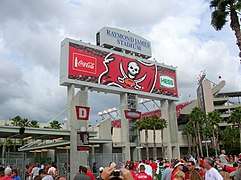 Entrance
Entrance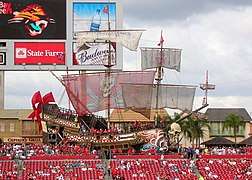 The pirate ship
The pirate ship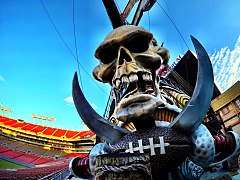 The pirate ship close-up
The pirate ship close-up- Stadium with Super Bowl XLIII decorations
- Tampa Sports Club Hall of Fame wall located at Raymond James Stadium
References
- "Patriots Sign Byars". The Ledger. October 16, 1996. Retrieved October 22, 2011.
- Federal Reserve Bank of Minneapolis. "Consumer Price Index (estimate) 1800–". Retrieved January 1, 2020.
- "Sports Facilities - FSC-Inc" (PDF). Archived from the original (PDF) on September 4, 2012.
- "Raymond James Stadium". Ballparks.com.
- "U2 Fans Line Up Before Dawn at Ray Jay Stadium". St. Petersburg Times. Archived from the original on June 7, 2011. Retrieved November 7, 2010.
- "Raymond James". www.raymondjames.com.
- Testerman, Jeff (January 25, 2001). "Super Bowl 2001: We Paid for It; It Paid Off". St. Petersburg Times. Retrieved July 28, 2012.
- "Bucs' New Stadium Gets A Name, New name is 'The Raymond James Stadium'". CBS News. December 13, 1999. Retrieved February 14, 2009.
- "Raymond James Stadium Naming Rights Through 2028". buccaneers.com. August 28, 2016.
- http://raymondjamesstadium.com/stadium-history/
- "Raymond James Stadium | Stadium Facts". Raymondjames.com. Retrieved February 14, 2009.
- "College Football National Championship Seating Chart 2017". Retrieved March 28, 2017.
- "Top Turf in the NFL? Cards Best, Steelers Worst". ESPN.com. January 29, 2009. Retrieved February 18, 2012.
- "Raymond James Stadium gets $140M Makeover". ESPN.com. August 28, 2016.
- Deggans, Eric (February 20, 2004). "Chris Thomas Touched Us All". St. Petersburg Times. Retrieved July 28, 2012.
- "Bucs Stay in Tampa With a Big Price Tag". Milwaukee Journal. January 17, 1995. Archived from the original on December 27, 2008. Retrieved February 14, 2009.
- Williams, Chareen (December 7, 1995). "Tampa Still Hopeful Bucs Will Stay Put". Orlando Sentinel. Retrieved July 28, 2012.
- Harry, Chris (July 24, 2005). "Fantastic Voyage". Orlando Sentinel. Retrieved July 28, 2012.
- Henderson, Joe (September 28, 1995). "Chipping In: Malcolm Glazer Says He'll Pay "About Half" the Cost of a New Stadium As a Seat-Deposit Plan Is Unveiled". The Tampa Tribune. Retrieved July 28, 2012.
- Washington, Wayne (September 18, 1998). "Stadium Rose Despite Challenges". St. Petersburg Times. Retrieved July 28, 2012.
- "In Pictures: The Most Valuable NFL Teams". Forbes.com. September 12, 2007. Archived from the original on October 11, 2008. Retrieved February 14, 2009.
- Testerman, Jeff (January 24, 2003). "Stadium Tax Helped Pay for Bucs' Success". St. Petersburg Times. Retrieved July 28, 2012.
- Canning, Michael (September 29, 2001). "Former Mayor's Opinion of Stadium Hasn't Changed". St. Petersburg Times. Retrieved July 28, 2012.
- Varian, Bill (April 18, 2003). "Tampabay: Tax Bill Swells as Bucs Stall". St. Petersburg Times. Retrieved February 14, 2009.
- Varian, Bill (March 6, 2003). "Hillsborough: Hillsborough Votes Yes on Plan to Own Stadium". St. Petersburg Times. Retrieved February 14, 2009.
- Varian, Bill (December 18, 2003). "Hillsborough: County Act Ends Tax on Stadium". St. Petersburg Times. Retrieved February 14, 2009.
- Contorno, Steve (October 1, 2015). "How the Raymond James Stadium negotiations between the Buccaneers and the Tampa Sports Authority broke down". Tampa Tribune / tbo.com. Archived from the original on September 15, 2016. Retrieved August 29, 2016.
- Pransky, Noah (December 3, 2015). "Bucs strike deal with county on stadium renovations". USA Today / WTSP. Retrieved August 28, 2016.
- Godfrey, John (June 9, 2012). "A World Cup Qualifying Victory Lacks Quality for the U.S". The New York Times.
- Carnevale, Scott (October 11, 2018). "USMNT Shows Fight But Falls 4-2 to Colombia". The Mane Land. Retrieved November 17, 2019.
- O'Reilly, Sean (January 9, 2017). "U2 to play Tampa's Raymond James Stadium on June 14th on 'The Joshua Tree 2017' summer tour".
- "How WWE Pulled Off WrestleMania 36 Without Fans and What It Means for Its Business and Future". The Hollywood Reporter. Retrieved April 9, 2020.
- Ramos, Dino-Ray (March 16, 2020). "WrestleMania To Stream Live Without Audience Due To Coronavirus Outbreak". Deadline. Retrieved March 17, 2020.
External links
| Wikimedia Commons has media related to Raymond James Stadium. |
| Events and tenants | ||
|---|---|---|
| Preceded by Tampa Stadium/Houlihan's Stadium |
Home of the Tampa Bay Buccaneers 1998 – present |
Succeeded by current |
| Preceded by University of Phoenix Stadium |
Home of the College Football Playoff National Championship 2017 |
Succeeded by Mercedes-Benz Stadium |
| Preceded by Jacksonville Municipal Stadium |
Host of the ACC Championship Game 2008–2009 |
Succeeded by Bank of America Stadium |
| Preceded by Tampa Stadium/Houlihan's Stadium |
Home of the Tampa Bay Mutiny 1999 – 2001 |
Succeeded by last stadium |
| Preceded by Georgia Dome University of Phoenix Stadium Hard Rock Stadium |
Host of the Super Bowl XXXV 2001 XLIII 2009 LV 2021 |
Succeeded by Louisiana Superdome Sun Life Stadium SoFi Stadium |
